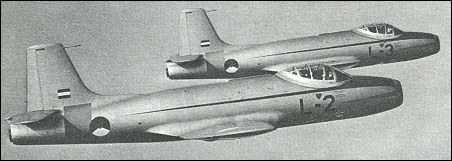 |
Fokker S.14 Mach-Trainer1951 |  |
| JET TRAINER | Virtual Aircraft Museum / Holland / Fokker |
 |
The Fokker S.14 Mach-Trainer secured its place in aviation history by being the first Fokker-designed jet aircraft, the first jet-propelled trainer designed as such, and the first aircraft of its type to enter production. The low-wing all-metal S.14 was powered by a Rolls-Royce Derwent turbojet with a bifurcated inlet in the nose. The outlet was in the extreme tail, aft of the horizontal tail surfaces, which were set somewhat aft of the fin and rudder. The nosewheel of the tricycle landing gear retracted forwards into the underside of the nose while the main units retracted inwards into the undersides of the wings. Pupil and instructor were seated side-by-side under a short, broad raised canopy set well forward on the circular-section fuselage. Martin-Baker ejector seats were standard. Test pilot Gerben Sonderman made the first test flight on 19 May 1951. On a second flight during the same day the landing gear failed and the prototype was damaged in the subsequent belly-landing. However, the aircraft was repaired and displayed at the 1951 Paris Salon in June of that year. A series of 20 S.14s was ordered by the Royal Dutch air arm, the Koninklike Luchtmacht, the first being flown initially on 15 January 1955. The prototype bore the serial K-1 and was powered by a Derwent V engine, while the production machines were serialled from L-1 to L-20 and had Derwent VIIIs. The S.14s served at four air stations: Twenthe, Ypenburg, Gilze-Rijen and Soesterberg. Aircraft L-4 was demonstrated in the USA during 1955, but crashed on 20 October that year at Hagerstown, Maryland, killing Gerben Sonderman. Aircraft L-8 took part in the London-Paris air race, known as the Arch to Arc since it started at Marble Arch and ended at the Arc de Triomphe. The last two S.14s were withdrawn from Dutch service on 29 March 1965. Serialled L-17 and L-19, they are preserved at the Museums at Schiphol and Soesterberg respectively. The original K-1 prototype was re-engined with a 2313kg thrust Rolls-Royce Nene 3 engine in 1953 and given the specially selected civil registration PH-XIV on 24 October 1960. It was then used by the Lucht en Ruuimtevaart Laboratorium (Dutch National Aeronautical and Space Laboratory) until scrapped on 4 March 1966.
|  COMPANY PROFILE | |||||||||||||||||||||||||||||||||||||||||||||||||||
 |

|

20
reply